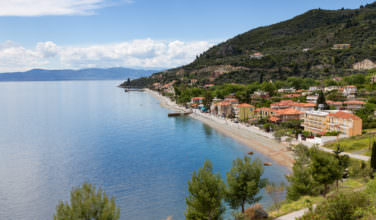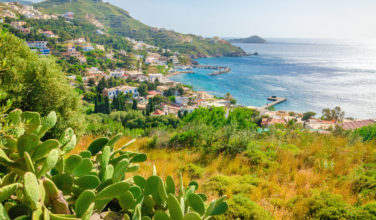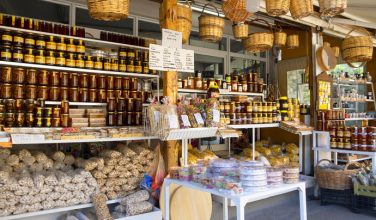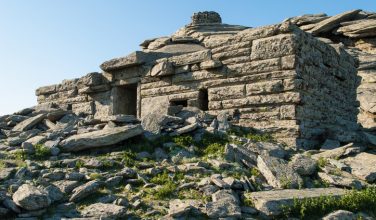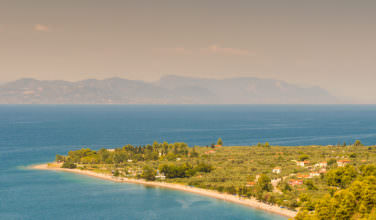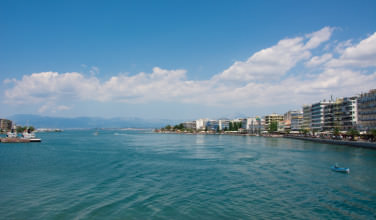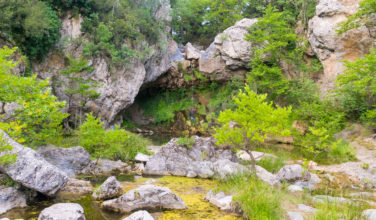Evia (or Euboea) is the second-largest Greek island after Crete. Evia is 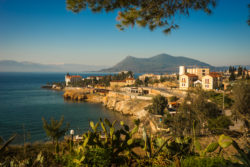 believed to have been part of the mainland that broke apart during an earthquake. According to Strabo and Thucydides, the northern part of the island had been shaken at various times, so this is a likely scenario. Evia has a mountainous center, forested northern area, and agriculture that is limited to the coastal valleys. The tallest mountain in Evia is Dirfi at 1,743 meters. The second tallest is Ochi at 1,398 meters.
believed to have been part of the mainland that broke apart during an earthquake. According to Strabo and Thucydides, the northern part of the island had been shaken at various times, so this is a likely scenario. Evia has a mountainous center, forested northern area, and agriculture that is limited to the coastal valleys. The tallest mountain in Evia is Dirfi at 1,743 meters. The second tallest is Ochi at 1,398 meters.
Much of the history of the island of Evia is concentrated in its two main cities: Chalcis and Eretria. Both cities were named in the Catalog of Ships. The Catalog of Ships is an epic catalogue in Homer’s Iliad (book 2). It is a list of contingents of the Achaean army that sailed to Troy. Chalcis and Eretria were both settled by Ionian Greeks from Attica. These two cities were rival cities. One of the conflicts between the two was called the Lelantine War. In 1830, Evia would become part of the independent Greek Kingdom.
Northern Evia is the perfect spot for people who love nature. There are mountain paths to hike, thermal springs, exotic islets, and petrified forests. Southern Evia is where you might spot dolphins swimming off the coast. The area also contains a number of shipwrecks deep under water. Central Evia is where Chalcis (also known as Chalkida) is located. If you’re a city lover and want to see medieval fortifications, you’ll want to visit central Evia. The island of Evia is rich in archaeological sites, so you won’t miss out no matter where you choose to spend your time.
The island of Evia is connected to the mainland via two bridges. One bridge runs through Chalcis and the other is from Athens. Evia’s modern bridges are suspended.
Administrative Region for Evia Island, Greece
Central Greece
Area of Evia Island, Greece
3,684 km2 (1,422 sq mi)
Population of Evia Island, Greece
191,206
Top Attractions in Evia Island, Greece
Archaeological Museum of Aidipsos – A small museum housed in the same building as the public baths. Artifacts include a marble depiction of Hercules and a Roman statue of the demigod. 4th century marble columns are also showcased.
Castle of Karababas – The castle stands on the mainland across from Halkida. Built at the end of the 17th century by the Turks. The castle is a monument to the area’s history over the last 300 years.
Mycenaen Tomb of Katakalos – Located in the small village of Katakalos. This is the most well-preserved tomb throughout Evia. The tomb is accessed through a 5.40 meter dromos (entrance passageway)
Venetian Tower at Avlonari – Located in the small town of Avlonari, 15 km from Kymi. A well-preserved Venetian tower. Renovations took place in 1953.
Agios Dimitrios Gorge – The gorge has a rich variety of flowers and trees. Plane and oak trees are especially abundant. Nature lovers will enjoy the Agios Dimitrios Gorge.
Castello Rosso (red castle) – A massive castle that was built in the 13th century. Castello Rosso would change hands several times, but under the Turks received its most impressive construction. It is in the seaside town of Karystos.
Drakospita – There are a number of locations across the southern region of Evia. These are the earliest structures dedicated to worship dating back to the Neolithic Era. Some of the most well-preserved Drakospita are on the summit of Mt. Ochi. Others are found just outside Viglia, Niborio, and Styra.
Agios Nikolaos of Molos – This is a church build into the rocks near the sea. It’s a very unique looking, but significant church. Located nearby is a windmill-like lighthouse.
Archaeological Museum – Created in 1967, this museum is located in Chora. Displayed are items found during excavations. The museum contains coins, jewelry, and pottery as well as the folklore collection of L. Kostoris.
Molos Beach – 4 km north of Skyros Town. Molos Beach is a long, sandy beach that has a relaxing atmosphere. The chapel of Agios Nikolaos is in close proximity to the beach.


